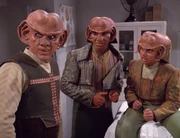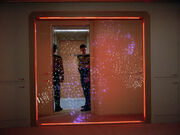Memory Alpha articles are never truly finished. Even featured articles, examples of Memory Alpha's best work, will over time have to undergo revisions to keep them up to date. Therefore, it's important to review the featured articles from time to time to ensure that these revisions have not only happened, but have maintained the quality expected of a featured article.
If you would like to help by starting a review, a good place to start is featured articles more than five years old, which are listed here. Please make sure you are familiar with the review policy before proceeding, though. For past reviews, please see the archive.
Reviews can be started by beginning a new discussion on this page. If you think that a featured articles' status should be upheld, add it to the "Uphold" section. If you think that the article should be removed from the feature article list, it should be added to the "Remove" section. Either way, be sure to state the reason(s) why you think the article should be reviewed. Reviews should display, and have a link to, the blurb used on the portals, by adding {{Blurb|ARTICLE}} before the discussion.
Sample format:
=== ARTICLE ===
{{Blurb|ARTICLE}}
<reasoning> - <signature>
Once this is done, a notice that the article's status is being reviewed should be added to the article in question by inserting {{far}} at the top of the page, above any other templates except the article type template.
When you are commenting on a review, please take the time to read the entire article before you decide whether to Support or Oppose the motion. When supporting or opposing an article, please use a bullet point (by adding a * before your comment) without any indent so these will be easy to find later. General comments should be indented as usual, and, as always, please sign your nominations and comments with "~~~~".
Uphold
Boothby

Mr. Boothby
Mr. Boothby was the curmudgeonly groundskeeper at Starfleet Academy in San Francisco on Earth. He was born in the mid to late 23rd century and has been working at Starfleet Academy since about 2321. He has seen a lot of promising young cadets come and go, often offering up helpful advice and kind words; among them such prominent Starfleet captains as Jean-Luc Picard, Kathryn Janeway, Richardson, and Lopez.
Boothby was disdainful of herbicides and other high-tech devices, and preferred to tend to the grounds by hand. After a big parrises squares win in 2324, it took Boothby three weeks to repair the grounds following the celebration. In 2368, Boothby claimed that he was cranky because he had been forced to replant the same flower bed several times.
I have carried out a full reorganization and expansion on this article to bring it up with today's standard's and I think it is now complete. A good article on another minor character with lots of properly cited background information and apocryphal mentions. --| TrekFan Open a channel 22:19, April 26, 2015 (UTC)
- Support. Seems pretty complete. StalwartUK 23:01, April 26, 2015 (UTC)
- Support. Agreed...--Sennim (talk) 22:10, May 4, 2015 (UTC)
- Support. - Archduk3 04:31, May 6, 2015 (UTC)
Star Trek design patents

Detail of an Issued Design Patent
Design patents are a type of patent issued under United States of America law. (Other locations have similar protections but they are called different things.) The patent is granted based on the unique appearance or concept of an item rather than its "usefulness". Design patents typically are sought for items where the appearance is as - or more - important than the underlying craftsmanship itself. So, things like jewelry, toys, furniture, car parts, etc. are frequently granted design patents.
Design patents have a life in the US of fourteen years from the date of issuance. Their main usefulness is as a supplement to copyright protections. Whereas someone claiming a copyright in a work can prevent actual copies being made, a design patent can more easily be used to prevent the unauthorized creation of similar items which are not actually copies. Neither protection is absolute, but some counsel believe that having both is important where even the hint of similar design is a threat to the value of the original design.
From 1978 through 1987, Paramount Pictures sought and obtained various design patents for Star Trek designs. There seem to have been no other filings after 1987, and Paramount's legal department instead probably feels comfortable with existing copyright protections.
In each instance of a design patent at least one "inventor" has to be listed. The inventor can never be the corporation, it has to be an individual or individuals. It is sometimes interesting to see who gets credit for what on the official documents.
This one is due to its age ready for a reappraisal. That being said, it is to this date one of the finest MA-articles I've ever laid eyes upon, as old as it is. Very few revisions have been made since the earliest days of MA , but few were required. In my view, the sublime organization and scope of the article are still beyond par, and it still deserves to be upheld as a FA...--Sennim (talk) 22:42, May 4, 2015 (UTC)
- Support: An interesting article. It appears complete and providing there are no further patents to be added, I am happy to support it's continued status as an FA. --| TrekFan Open a channel 22:59, May 4, 2015 (UTC)
And you know what, virtually none of it was mine, but from an earlier contributor...When I came upon this article, I was mightily impressed by the way that ancient archivist organized the article. (btw, as far as I could ascertain, Paramount ceased going for patents after TNG-S1, or in other words 1987)--Sennim (talk) 23:13, May 4, 2015 (UTC)
Ferengi

Three Ferengi males: Quark, Rom, and Nog
The Ferengi were a spacefaring humanoid species native to the planet Ferenginar. Ferengi civilization was built on the ideals of pure laissez-faire capitalism, in which all other goals were subjugated to the pursuit of profit.
Their governing body, known as the Ferengi Alliance, was formed over a period of ten thousand years, beginning with the establishment of a system of currency, to their purchase of warp technology, and finally to its current state in the 24th century.
The Ferengi culture had roots similar to that of the many other species, filled with wars, violence, and greed. However, Ferengi managed to avoid many of the worst aspects of an evolving culture and their social history is notable for the absence of atrocities such as slavery or genocide, a distinction the Ferengi felt makes them morally superior. Ferengi culture slowly grew out of its early stages by introducing a remarkable economic system that developed from early bartering systems to become one of the leading cultures in interstellar commerce.
A still excellent article that deserves to remain an FA. This one is extremely detailed and has a tremendous amount of background information. --| TrekFan Open a channel 23:16, May 8, 2015 (UTC)
Remove
Force field

A security force field in 2364
A force field was an energy barrier with many applications and varying degrees of strength. Although force fields had been in use for many years, Starfleet did not begin research on such a device until 2147, then referred to by Malcolm Reed as a "stable EM barrier." By the 24th century, Starfleet force fields were commonplace and were rated by intensity, ranging in strength from level 1-10. A level 10 force field was the strongest, and would be used, for example, during a scientific experiment of which the outcome was unknown, or known to be explosive in nature. Applications range from creating holograms, to sealing a hull breach, to personal force fields designed to keep potential assailants at bay.
The effects of a force field on its surroundings varied greatly. Contact with a force field could cause anything from a slight tingle to death. Most force fields were non-lethal, although some civilizations, such as the Dominion, preferred the lethal variety. If a force field was active, an object or transporter beam generally could not pass through it.
This article, while thorough from an in-universe perspective, is lacking any background/production information (of which I am sure there is plenty). Unfortunately, I don't have the time to go through all my sources to add it at the moment so I propose that the article's FA status be removed pending future any improvements that can be made to it. In addition to BG info, I am sure there is a host of apocryphal information on force fields and I just feel that this article is in no way 100% complete and so shouldn't be an FA. --| TrekFan Open a channel 17:16, April 23, 2015 (UTC)
- I'm inclined to say that this meets the criteria, since without knowing for sure how much, or the quality of, any information that might be missing, I really can't say that this isn't "as complete as possible". That said, I'm not opposing this as yet, but I would rather not remove a FA because of "what might be". - Archduk3 05:06, April 24, 2015 (UTC)
That's a fair comment, Archduk3. If I get some spare time over the weekend, I'll traul through my references and make a few scribbled notes for the talk page of the article. I'm certain I've seen BG info relating to force fields though. --| TrekFan Open a channel 15:47, April 24, 2015 (UTC)
- Undecided; Truth to be told, I'm inclined to support TrekFan's position for removal. While Duke is absolutely right in his assessment that lack of info in itself is no reason for refusing a FA status as per the criteria, it should also be noted that these criteria were constituted at the beginning of MA when it was primarily intended to be an in-universe POV site. But as everything else, MA has evolved over time, most notably to have production POV info included as BG-info. As a consequence, perusing over the new FA articles added over the last five years, a BG and an aprocrypha section, no matter how trivial, was almost obligatory to have been included; The bar, while not formally but certainly implicitly, has been raised considerably since those early days so to speak...Sennim (talk) 21:59, May 4, 2015 (UTC)
- While that's generally true, I don't think this subject lends itself to those sections being included though, as the concept of force fields predates Star Trek, and the on screen effects do as well for the most part. There might be some episode specific bg info on the use of, or the visual effect used for, a force field, but I'm not aware of them off the top of my head, nor can I think of a noteworth use of a force field in apocrypha sources that isn't simply "a force field was used." Force fields tend to be treated as light switches in plots, they're either on or off, should be on or off, or need to be switch on or off, but not really noteworthy beyond that. - Archduk3 04:51, May 6, 2015 (UTC)
I have listed some potential sources of what I consider to be very relevant force field background information on the article's talk page. This is just an example. I am sure if I had the time, I could sit down and find many more to expand the article with. Though I appreciate what you are saying Archduk3, I am still of the opinion, the article is not complete and therefore shouldn't be an FA yet. --| TrekFan Open a channel 22:32, May 8, 2015 (UTC)
